Physical Address
304 North Cardinal St.
Dorchester Center, MA 02124
Although there are numerous tissues and structures that make up the chest wall, based on their radiographic presentation, its components can be grouped into two major parts: the soft tissues and the bony structures. Chest wall tumours can arise from either component; the approach to and differential of these lesions will be considered separately.
On the chest radiograph the soft tissues present as areas of increased density that in part project next to the bony chest wall and in part overlay the different components of the chest. Abnormalities of the soft tissues will present as an abnormal increase or decrease in density often combined with the appearance of an abnormal contour or the disappearance of a normal contour.
Because of better density resolution and multiplanar reformatting, computed tomography (CT) can better demonstrate the different tissues of the chest wall. CT has the advantage over magnetic resonance imaging (MRI) of higher spatial resolution and the ability to better identify bony structures. However, MRI yields greater soft-tissue contrast, which can be important. Multiplanar imaging and three-dimensional (3D) reformation can be performed with both techniques.
Ultrasound may also be used to examine the chest wall. In general, it provides less detailed and comprehensive information, but it usually enables the lesion to be localised, allows a distinction to be made between cystic and solid lesions and enables guided aspiration/biopsy to be performed under imaging control.
Positron-emission tomography (PET)/CT using the isotope fluorodeoxyglucose (FDG) provides some extra diagnostic information and is useful to determine the metabolic activity of chest wall masses and the presence of local or distant metastases. Particular added value is in the planning of a chest wall/pleural mass biopsy, where identification of the most metabolically active region facilitates targeted sampling and increases the likelihood of a positive biopsy.
On the female chest radiograph it is mandatory to check that both breasts are present. Unilateral radical mastectomy is usually easy to detect because it generates a unilateral mid/lower zone transradiancy and an abnormally straight anterior axillary fold that passes upwards and inwards towards the mid clavicle ( Fig. 3.1 ). Bilateral radical mastectomy is more difficult to identify, but an overall increase in basal transradiancy and axillary fold abnormalities should provide adequate clues. Surgical interventions short of radical mastectomy may be impossible to detect, but close attention to the relative transradiancy of the breast regions and to the breast contours may provide suggestive findings. In addition, the presence of vascular clips can be helpful.
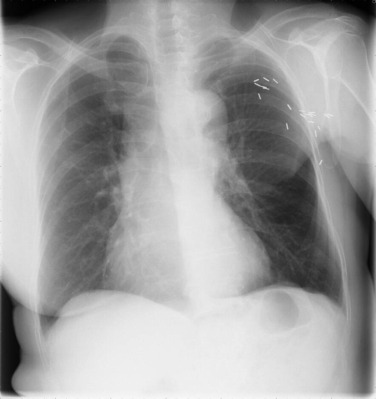
Nipple shadows can mimic intrapulmonary nodules. A putative nipple should be checked for compatible size (5–15 mm), shape and location—its relation to the breast outline in a woman or the pectoralis opacity in a man.
On the chest radiograph the pectoralis major produces a broad, band-like opacity extending downwards and medially from the axilla. Unilateral absence or hypoplasia of the pectoralis major results in a unilateral transradiancy and an abnormal anterior axillary fold as seen with mastectomy. In Poland syndrome these changes are accompanied by ipsilateral hand and arm anomalies (particularly syndactyly) with or without absence of pectoralis minor, rib anomalies and hypoplasia of breast and nipple.
Soft-tissue calcification may occur in the chest wall, and clues to its site and nature are provided by its morphology distribution and the clinical history. Possible causes to consider include granulomatous lymph nodes, parasites ( Taenia solium and Dracunculus medinensis ), calcinosis universalis, childhood dermatomyositis, tuberculosis (spine, ribs or soft tissues) and bone neoplasms. Ossification is rare and most commonly seen in fibrodysplasia ossificans progressiva.
Subcutaneous emphysema of the chest wall is not uncommon following surgery, pleural drain placement or trauma or in cases of spontaneous or acquired pneumomediastinum. Air dissects along tissue planes and between muscle bundles, giving an overall pattern of linear transradiancies which can significantly interfere with the interpretation of the underlying structures. In this way, diagnosis of pneumothorax can become very difficult ( Fig. 3.2 ). In case of doubt, CT can be performed.
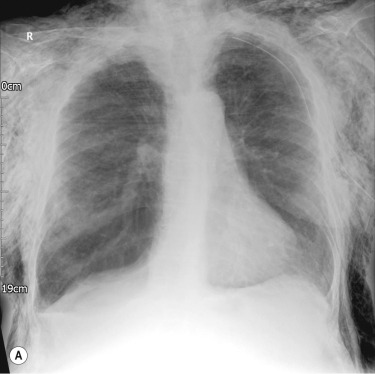
Although depicting bone abnormalities is not the primary goal of a chest radiograph, the bony structures that are, as a result of the technique, often only partially visible should be carefully examined. CT, when indicated, characterises any bone lesion and is better at demonstrating congenital or acquired remodelling or complicated fractures; multidetector 2D or 3D reformations can be helpful.
There are normally 12 pairs of ribs. Cervical ribs occur in 1%–2% of the population and are commonly bilateral, although often asymmetrical, and may cause thoracic outlet syndrome.
Congenital abnormalities of modelling may be confined to one or two ribs or be generalised. One or a few upper ribs are commonly bifid, splayed, fused or hypoplastic. Usually occurring in isolation, these anomalies are occasionally part of a syndrome (e.g. basal cell naevus syndrome) or associated with other anomalies (e.g. Sprengel deformity).
With acquired remodelling, abnormalities tend to be focal, affecting one or many ribs. Such acquired changes may follow fracture, surgery, osteomyelitis and empyema drainage or result from external pressure (rib notching) ( Fig. 3.3 ). The two main causes of rib notching are coarctation of the aorta and neurofibromatosis type I.
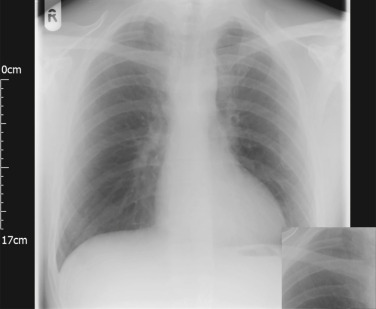
Ribs may fracture, and the callus formed can sometimes mimic an intrapulmonary opacity.
Destructive rib lesions occur most commonly in osteomyelitis or neoplastic disease. The former is uncommon and may be haematogenous (e.g. staphylococcal or tuberculous) or caused by direct spread from lung and pleural space (e.g. in actinomycosis). Bronchial carcinoma, including Pancoast tumour, commonly spreads from lung to rib. In this latter condition, MRI can be performed to study the extent of the disease, especially the relationship between the tumour and the plexus brachialis in case of a Pancoast tumour ( Fig. 3.4 ). Multidetector CT (MDCT) can also play an important role, especially because it can better evaluate the invasion in the bony cortex of the ribs (see Fig. 3.4D ). In addition, 3D image reconstruction methods can be used in selected cases to clarify a complex relationship between the tumour invading the chest wall and vascular structures of the thoracic inlet.
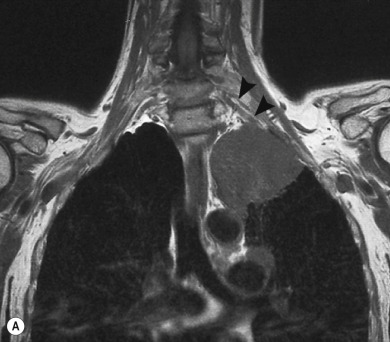
This is well displayed in a lateral chest radiograph but is relatively inconspicuous in the frontal projection, in which only the manubrial margins are sometimes visible, giving rise to confusing shadows that may mimic mediastinal widening.
Various sternal deformities are described, and the most important radiologically is the depressed sternum (funnel chest, pectus excavatum) in which there is approximation of the lower half of the sternum and the spine ( Fig. 3.5 ). This may be an isolated abnormality or it may be associated with other disorders such as Marfan syndrome or congenital heart disease (particularly atrial septal defect [ASD]). The radiological signs on a posteroanterior (PA) chest radiograph consist of a shift of the heart to the left, straightening of the left heart border with prominence of the main pulmonary artery segment, loss of the descending aortic interface and an increased opacity in the right cardiophrenic angle, often accompanied by a loss of clarity of the right heart border which simulates right middle lobe disease. The diagnosis can be suspected on a PA radiograph from the steep inferior slope of the anterior ribs and undue clarity of the lower dorsal spine seen through the heart.
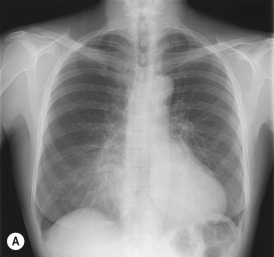
Pigeon chest (pectus carinatum) represents the reverse deformity and may be congenital or acquired.
CT is the best investigation for imaging the sternum because it eliminates overlapping structures, detects bony destruction, allows imaging of adjacent soft tissues (the parasternal–internal mammary zone) and has good contrast resolution superior to that of conventional radiography or tomography.
The medial clavicular ends are important landmarks used together with the spine in assessing rotation on a radiograph.
The joints at both ends are synovial but only the acromioclavicular joint can be assessed with confidence on a chest radiograph. It may be eroded in any synovitis, particularly rheumatoid arthritis, and is also commonly fuzzy and ill-defined in hyperparathyroidism and rickets. Either CT or MRI is required to provide a full evaluation of the medial clavicular ends in cases of clavicular lesions.
The scapula is an important point of muscular attachment. Paralysis of the long thoracic nerve may occur from trauma or surgery or may be idiopathic and account for scapula winging and an asymmetrical appearance of chest radiograph. Sprengel deformity is a congenital elevation and rotation of the scapula, with the inferior angle directed laterally. An omovertebral bar (fibrous or osseous) is present in approximately a third of cases, running from the superomedial border of the scapula to the lower cervical vertebrae. Sprengel deformities are associated with other abnormalities such as Klippel-Feil syndrome or spina bifida.
Kyphoscoliosis makes assessment of the chest radiograph difficult, and CT is often necessary to evaluate possible thoracic disease.
On the chest radiograph, several radiological signs aid differentiation between a tumour of the chest wall and an intrathoracic tumour. The border between the mass and the adjacent lung is usually sharp, whilst being indistinct with the adjacent chest wall soft tissue. A chest wall tumour indents the pleura, forming obtuse angles and a tapered border, compared with intrapulmonary masses which form acute angles with the pleura. Tumours arising from osseous structures often grow along or destroy underlying bone, whilst those with a lymph or nervous system origin occur in a paraspinal or intercostal location and cause bone erosion.
In general, benign lesions cause rib erosion, separation and notch-like remodelling without cortical destruction, whilst malignant and inflammatory lesions result in bony destruction. A chest wall tumour with bony destruction in an adult is most likely due to metastatic disease (commonly breast, lung or kidney), multiple myeloma, lymphoma, sarcoma or primary bone tumour. Ewing sarcoma and neuroblastoma should be considered in children.
Malignant tumours enhance with intravenous contrast agents, whilst benign lesions usually cause displacement of the vasculature. Maximum intensity projections may be used to identify feeding vessels of chest wall tumours.
Although patients with benign chest wall tumours usually suffer no symptoms, most patients with malignant chest wall neoplasms present with chest pain.
The most common benign chest wall tumour is a lipoma , but a variety of other mesenchymal tumours occur, including neurilemmomas (schwannomas), neurofibromas, haemangiomas and lymphangiomas (cystic hygromas) .
On CT, lipomas are well-demarcated homogeneous masses of low density (−90 to −150 HU). They contain few, if any, other soft-tissue components; the presence of the latter in a fatty tumour suggests a liposarcoma. MRI features are also characteristic, with high signal on T 1 weighted images, intermediate signal on T 2 weighted images and low signal with fat suppression.
Neurilemmomas (schwannomas) on CT are isodense to the spinal cord and enhance postcontrast medium administration, with those that are paraspinal in location often having a dumbbell appearance. On MRI they are T 1 isointense or hypointense, are T 2 heterogeneously hyperintense and show intense enhancement post gadolinium. They may demonstrate areas of cystic degeneration and hemosiderin.
Neurofibromas have a similar appearance to neurilemmomas and are usually solitary and localised but may be diffuse and plexiform in pattern in patients with neurofibromatosis type 1. On CT they appear as a hypodense mass but differ from neurilemmomas in having minimal or no contrast enhancement and rarely any cystic degeneration. On MRI, neurofibromas are low-to-intermediate signal on T 1 weighted images but high signal on T 2 weighted images, with the target sign (hyperintense rim with central region of low signal) being highly suggestive of neurofibroma, although some neurilemmomas may exhibit this sign. There is heterogeneous enhancement after intravenous gadolinium-based agents.
Haemangiomas are uncommon lesions that occasionally show phlebolithic calcification on plain radiography. Findings on CT include phleboliths, bone remodelling and an enhancing mass. MRI is the best investigation for delineating their extent. Lesions give an intermediate signal on T 1 weighted images and a high signal on T 2 weighted images, accompanied by artefacts generated by vessels, soft tissue and elements derived from haemorrhage. Lymphangiomas on CT have the features of a fluid-filled cyst with or without septation. On MRI they have the features of a cyst with low protein content.
Elastofibroma dorsi is a benign soft-tissue mass adjacent to the scapula thought to result from repetitive trauma, that commonly presents incidentally. They are usually nonencapsulated crescentic masses, that may be FDG PET-avid ( Fig. 3.6 ).
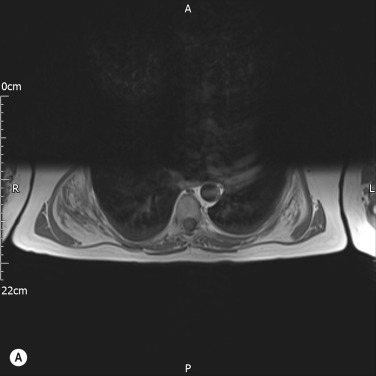
Malignant primary tumours arising in the soft tissues of the chest wall are unusual, the most common being liposarcomas or fibrosarcomas ( Fig. 3.7 ). Although a well-differentiated liposarcoma is composed of 50%–75% adipose tissue, this malignant neoplasm usually contains internal structures such as septa or soft-tissue nodules which enhance after intravenous administration of contrast media.
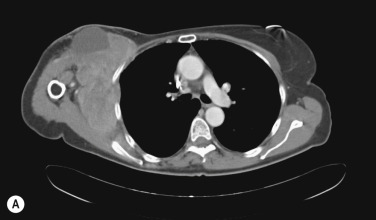
Fibrohistiocytic neoplasm (UPS, undifferentiated pleomorphic sarcoma, formerly malignant fibrous histiocytoma) is classified as a fibrohistiocytic malignancy and is the most common malignant soft-tissue neoplasm of the chest wall in adults. Women are more frequently affected than men, at a mean age of 55 years. UPS originates from the deep fascia or skeletal muscle. Three histological subtypes are differentiated: high-grade pleomorphic sarcoma, pleomorphic sarcoma with giant cells and pleomorphic sarcoma with prominent inflammation. In CT the soft-tissue mass involves the deep fascia and the muscles, rarely osseous structures are involved and enhancement after contrast medium administration is heterogeneous. On MR, signal intensity is very variable according to the proportion of the predominant collagen (low signal on all MR sequences), haemorrhagic or myxoid tissue components (low on T 1 and high signal on T 2 weighted sequences).
Angiosarcoma is the most common primary malignant neoplasm of vascular origin and usually presents as a large painful and rapidly enlarging chest wall lesion associated with the clinical features of haemorrhage, anaemia and coagulopathy. Angiosarcoma is often associated with lymphoedema, especially after mastectomy for breast cancer. The most common location is therefore, not surprisingly, the chest wall in patients with a history of breast cancer. At CT and MR, angiosarcomas are heterogeneous with internal regions of necrosis, haemorrhage and vascularity. FDG PET demonstrates heterogeneous but generally increased FDG uptake.
Secondary tumours of the chest wall are common. They may be due to direct invasion or metastases from adjacent tumours of the lung, breast, pleura and mediastinum. Lymphoma of the chest wall is rare and typically results from direct invasion by Hodgkin lymphoma or large B-cell lymphoma arising from the mediastinum or axilla. It is a sign of poor prognosis. Most secondary invasive lesions demonstrate increased FDG uptake, and PET/CT can be used for tumour staging.
Clues to differentiate benign from malignant chest wall bone lesions are age, location and tumour aggressiveness. The most common primary malignant bone tumour of the chest wall in adults is chondrosarcoma , whilst metastatic disease and multiple myeloma are the most common secondary malignant causes and are often multifocal. In children, Ewing sarcoma is the most common primary malignant bone lesion. Osteochondroma, chondromas and fibrous dysplasia represent the most common benign bony tumours ( Fig. 3.8 ).
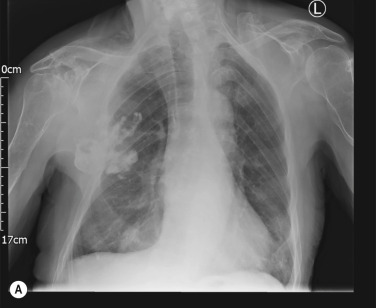
Localised lesions of the ribs have an equal likelihood of being benign or malignant. Chondromas and osteochondromas (exostoses) are predominantly anterior and may show characteristic cartilaginous calcification, whilst fibrous dysplasia is a lytic bone lesion with a ground-glass matrix usually involving the posterior ribs ( Fig. 3.9 ). Eosinophilic granulomas (the preferred term nowadays) haemangiomas and aneurysmal bone cysts may also occur in the ribs.
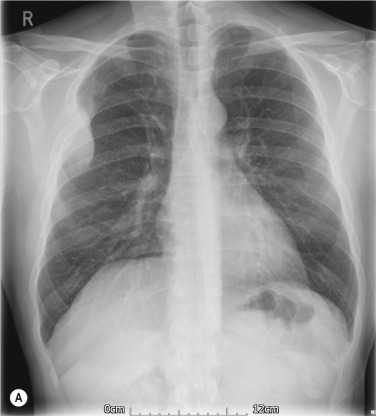
The most common malignant rib tumours are metastatic deposits and myeloma . The most common primary malignant bone tumour, chondrosarcoma , usually involves the anterior chest wall at the costochondral arches adjacent to the sternum and has the appearance of a lytic lesion with a chondroid matrix. Other malignancies that occur occasionally include lymphoma, osteosarcoma and round cell tumours.
Neoplasms of the clavicle and sternum are usually malignant (myeloma or metastatic). Other malignant tumours include osteosarcoma, Ewing sarcoma, postradiation sarcoma, chondrosarcoma and lymphoma. Nonneoplastic processes that may affect the clavicles and sternum include osteomyelitis, eosinophilic granuloma Paget disease, fibrous dysplasia, osteitis fibrosa cystica and intersternocostoclavicular hyperostosis.
Composed of soft tissues and bony structures with different abnormalities arising from each component
Soft tissues:
Abnormalities or variants of the breasts and muscles, soft-tissue calcification and subcutaneous emphysema affect the radiological appearance of the chest wall.
Tumours include benign causes (lipoma, neurilemmomas, neurofibromas, haemangiomas, lymphangiomas, elastofibroma) and malignant causes that may be primary (liposarcoma or fibrosarcoma, undifferentiated pleomorphic sarcoma, angiosarcoma) or secondary (direct metastatic invasion, lymphoma).
Bone:
Abnormalities or variants of the ribs, sternum, clavicles, scapula and spine affect the radiological appearance of the chest wall.
Tumours include benign causes (chondromas, osteochondromas, fibrous dysplasia, eosinophilic granuloma haemangiomas and aneurysmal bone cysts) and malignant causes which may be primary (chondrosarcoma, osteosarcoma, Ewing sarcoma, postradiation sarcoma, lymphoma) or secondary (myeloma or metastatic).
The chest radiograph is still the most important and widely used means of demonstrating and following the progress of pleural disease, although ultrasound, CT, MRI and now FDG PET/CT can play a significant role in a number of specific situations. Pleural disease is manifest by the accumulation of fluid or air in the pleural space, by pleural thickening (with or without calcification) or by the presence of a pleural mass.
A number of different types of fluid may accumulate in the pleural space, the most common being transudate, exudate (thin or thick), blood and chyle. Occasionally effusions are highly specific, not falling into any of the aforementioned categories and containing, for example, bile, cerebrospinal fluid or iatrogenic fluids. All types of pleural effusion are radiographically identical, although historical, clinical and other radiological features may help limit the diagnostic possibilities. Sometimes, CT and MRI can also help to specify the diagnosis.
Bilateral pleural effusions tend to be transudates because they develop secondary to generalised changes that affect both pleural cavities equally—a rise in capillary pressure or a fall in blood proteins, etc. Some bilateral effusions are exudates, and this is seen with metastatic disease, lymphoma, pulmonary embolism, rheumatoid disease, systemic lupus erythematosus (SLE), post–cardiac injury syndrome, myxoedema and some ascites-related effusions. Right-sided effusions are typically associated with ascites, heart failure and liver abscess, and left effusions with pancreatitis, pericarditis, oesophageal rupture and aortic dissection. Massive effusions are most commonly due to malignant disease, particularly metastases (lung or breast), but may also occur in heart failure, cirrhosis, tuberculosis, empyema and trauma.
A small amount of free fluid may be undetectable on an erect PA chest radiograph because it tends initially to collect under the lower lobes. Such small subpulmonary effusions can be demonstrated by ultrasound or CT.
As the amount of effusion increases, the posterior and then the lateral costophrenic angles become blunted, by which time a 200- to 500-mL effusion is present. Following this the classical signs develop: homogeneous opacification of the lower chest with obliteration of the costophrenic angle and the hemidiaphragm. The superior margin of the opacity is concave to the lung and is higher laterally than medially. Above and medial to this meniscus there is a hazy increase in opacity owing to the presence of fluid posterior and anterior to the lungs ( Fig. 3.10 ). A pleural effusion of approximately 1000 mL is usually present by the time the pleural effusion reaches the level of the fourth anterior rib.
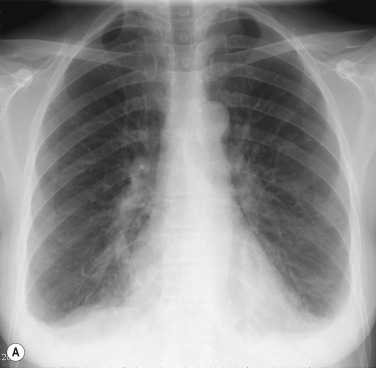
Massive effusions cause dense opacification of the hemithorax with contralateral mediastinal shift ( Fig. 3.11 ). Absence of mediastinal shift with a large effusion raises the strong possibility of obstructive collapse of the ipsilateral lung or extensive pleural malignancy, such as may be seen with mesothelioma or metastatic carcinoma ( Table 3.1 ). Large effusions sometimes cause diaphragmatic inversion, particularly on the left where the diaphragm lacks the support of the liver. Paradoxical hemidiaphragmatic motion may occur as a result on the affected side. For small effusions, a lateral decubitus radiograph can increase sensitivity for the detection of a pleural effusion as the pleural liquid moves with gravity and the lung effectively floats on the effusion. However, ultrasound will often be an easier technique to demonstrate a small pleural effusion, and most institutions no longer perform lateral decubitus x-rays. Although pleural fluid collects initially under the lung, it is unusual for it to remain localised in this site once its volume exceeds 200–300 mL. This does happen occasionally and may be suspected from an erect PA and lateral radiograph. On a PA radiograph this subpulmonary effusion presents as a ‘high hemidiaphragm’ with an unusual contour that peaks more laterally than usual, has a straight medial segment and falls away rapidly to the costophrenic angle laterally, which may or may not be blunted. If occurring on the left, a separation of more than 2 cm of the stomach bubble from the lung, particularly if displaced inferomedially, may provide further evidence. Ultrasound or CT will confirm the diagnosis ( Fig. 3.12 ).
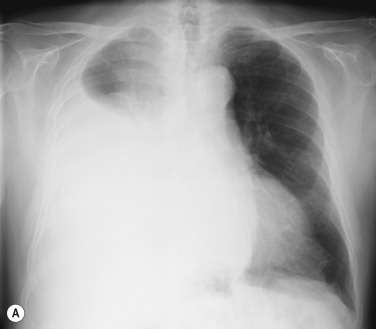
| Pleural effusion Consolidation Collapse Massive tumour Fibrothorax Combination of above lesions Pneumonectomy Lung agenesis |
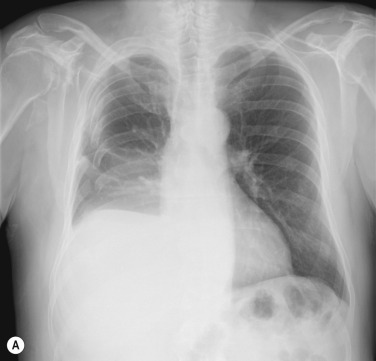
Fluid can loculate between visceral pleural layers in fissures or between visceral and parietal layers, usually against the chest wall. This often results from adhesions, and commonly an additional radiographic clue to the presence of pleural disease will be present ( Fig. 3.13 ). Transudates may cause loculation without adhesions, particularly within the interlobar fissures mimicking masses, and have been called pseudotumours or vanishing tumours. Occasionally, distinguishing between loculated pleural fluid and a pleural mass can be challenging. Helpful indicators are that the lesion is homogeneous, smooth when seen in tangent but poorly circumscribed when seen ‘en face’, and changes configuration between supine and erect films as a result of gravity. Both ultrasound and CT can be used to distinguish loculated fluid from solid lesions.
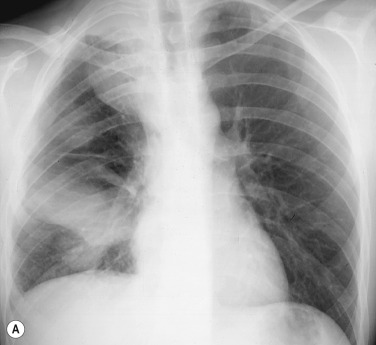
In the supine patient, pleural fluid layers out posteriorly and the meniscus effect, present from front to back, is not appreciated because of the projection. The main radiographic finding is a hazy opacity like a veil affecting the whole or the lower part of the hemithorax, with preserved vascular opacities in the overlying lung and lack of air bronchograms (see Fig. 3.10B ). An apical cap that disappears on upright imaging may occur with as little as 175 mL of fluid. Additional signs include haziness of the diaphragmatic margin, blunting of the costophrenic angle, thickening of the minor fissure and widening of the paraspinal interface.
Pleural fluid, especially when it is a transudate, is commonly echo free and marginated on its deep aspect by a highly echogenic line at the fluid–lung interface. Exudative and haemorrhagic effusions may be echogenic and are often accompanied by pleural thickening. The pattern of echoes may be homogeneous, complex or septated. Features that help distinguish a fluid from a solid echogenic lesion include changes in shape with breathing, the presence of septa and fibrous strands and movement of components induced by breathing ( Fig. 3.14 ). Occasionally, in the absence of such features, some echogenic fluid pleural effusions are indistinguishable from solid pleural lesions.
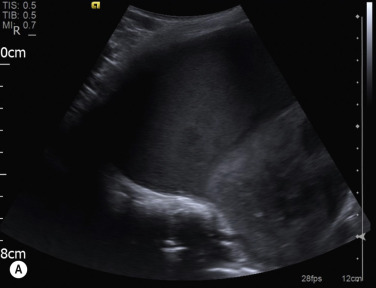
Ultrasound has a number of important roles in the evaluation and management of pleural fluid. It can be used to distinguish between pleural fluid, solid pleural (or extrapleural) lesions and peripheral lung lesions. In peripheral lung lesions, the presence of fluid bronchograms and vessels on Doppler examination will positively identify consolidation. In addition, pleural lesions characteristically make an obtuse angle with the chest wall, whereas with intrapulmonary lesions the angle is often acute . This ability of ultrasound to distinguish pulmonary lesions (collapse, consolidation, abscess) from pleural effusion is particularly useful when it comes to the evaluation of the opaque hemithorax. Ultrasound can also be used to identify small amounts of pleural fluid or pleural fluid in unusual locations, as with a subpulmonary effusion (see Fig. 3.12C ). Ultrasound is widely used to localise pleural fluid for aspiration and identify any solid components to allow guided biopsy. Furthermore, ultrasound may identify the cause of an effusion when it lies inside or even outside the chest (subphrenic abscess, metastasis, etc.).
CT is very sensitive in detecting pleural fluid and can distinguish between free and loculated fluid, identifying the extent and location of the latter. Accurate localisation of such loculated effusions is essential before drainage procedures. CT distinguishes between parenchymal lung disease and pleural disease, a distinction often facilitated by administration of intravenous contrast medium. Furthermore, it is useful to differentiate an empyema from a lung abscess in patients with infective symptoms. CT can characterise the morphology of pleural thickening that often accompanies a pleural effusion, distinguishing between malignant (nodular, with focal masses) and benign thickening, which is typically uniform. CT can also visualise the obscured underlying lung, identify any underlying thoracic or upper abdominal abnormalities that might have provoked an effusion and facilitate percutaneous aspiration and biopsy ( Fig. 3.15 ).
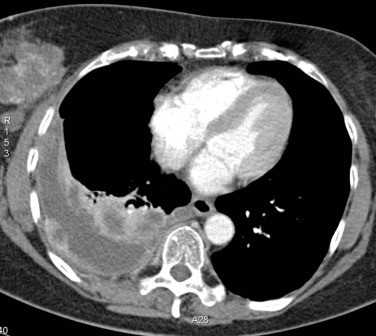
A pleural effusion appears on CT as a dependent sickle-shaped opacity with a CT number lower than that of any adjacent pleural thickening or mass. CT numbers do not allow a distinction between transudate and exudate. However, parietal and visceral pleural thickening and enhancement at contrast-enhanced CT (‘split-pleura’ sign) almost always indicates the presence of pleural exudates, most commonly due to malignant effusion or pleural infection. The higher density of clotted blood in a haemothorax is sometimes apparent. The fat-containing chylothorax does not have a CT number lower than normal, because of its protein content. Loculated effusions have a lenticular configuration with smooth margins, and they displace the adjacent parenchyma.
MRI has a limited role in the evaluation of pleural effusion, although it may be helpful to distinguish a transudate from an exudate. Pleural fluid has a low signal on T 1 weighted sequences and a high signal on T 2 weighted images, often with heterogeneous appearances as a result of motion within the effusion creating flow artefacts. Exudates tend to give a higher signal than transudates on T 2 weighted sequences, although variability in the albumin content of blood and pleural fluid between individuals makes this feature unreliable. Complex exudates have greater signal intensity than simple exudates, with septations and nodularity showing late gadolinium enhancement. It may also be possible to differentiate transudates from exudates using triple echo-pulse sequence and diffusion-weighted imaging where transudates have been shown to have lower apparent diffusion coefficient (ADC) values. Although MRI is of limited value in detecting pleural infection, it is of value in assessing pleurocutaneous fistulae and associated osteomyelitis. High-resolution MRI can also help to differentiate benign from malignant changes, with its superior contrast resolution identifying small pleural nodules within the background effusion. Chylous effusion can cause high signal intensity on T 1 weighted images similar to subcutaneous fat. In the subacute and chronic stage, haematomas show bright signal intensity on T 1 weighted images, surrounded by a dark rim caused by haemosiderin.
Increased uptake of glucose in malignant cells and those responding to inflammation and infection can help differentiate a transudate from an exudate on FDG PET/CT. In certain cases, it may help differentiate benign from malignant pleural effusions, particularly in cases with a solid pleural component; however, it is not reliable enough to warrant routine inclusion in the work-up of effusion of undetermined cause.
Pleural effusion is common in left ventricular failure and bilateral in approximately 90% cases, although occurring more frequently and larger on the right.
All types of pericardial disease may be associated with pleural effusion, which is predominantly left sided. A pleural effusion is a characteristic finding in the post–cardiac injury syndrome, seen in approximately 80% of patients. It may be bilateral or unilateral and is commonly accompanied by consolidation and pericardial effusion. Pulmonary embolism is commonly associated with a pleural effusion, which is seen in 25%–50% of cases but is usually small and may be haemorrhagic.
A number of drugs have been described as causing pleural effusions. The most common agents are cytotoxics (methotrexate, procarbazine, mitomycin, busulfan, bleomycin and interleukin-2), nitrofurantoin, antimigraine drugs (ergotamine, methysergide), amiodarone, propylthiouracil, bromocriptine and gonadotrophins. With a number of these agents, pleural thickening is more common than a pleural effusion. Both acute and chronic pancreatitis are associated with pleural effusions which have high amylase levels. In acute pancreatitis, exudative and often blood-stained effusions form in 15% of patients, particularly on the left side, where the diaphragm is closely related to the pancreatic tail. Associated elevation of the hemidiaphragm and basal lung consolidation are common. In chronic pancreatitis, effusions tend to be large and recurrent, and patients present with dyspnoea, unlike effusions in acute pancreatitis in which abdominal symptoms predominate. Pleural effusion is common with subphrenic abscess and occurs in approximately 80% of patients. The effusion is often accompanied by basal lung collapse and consolidation, an elevated hemidiaphragm and, on occasion, a subdiaphragmatic air–fluid level.
Pleural effusion may occur in a number of renal conditions. Exudative effusions may be seen in uraemia and are often accompanied by pericarditis. Effusions can be large or small and are often unilateral, behaving in a rather indolent fashion. In common with other hypoproteinaemic states, bilateral effusions develop in approximately 20% of patients with nephrotic syndrome. Peritoneal dialysis can produce pleural effusions by the direct transdiaphragmatic passage of fluid, as occurs with cirrhotic ascites. In common with other ascites-related effusions, they are predominantly right sided, but these effusions have a diagnostically high level of glucose. Rarely, a urinothorax may be caused by ipsilateral obstructive uropathy and is reversible following removal of urinary tract obstruction.
Patients with acquired immune deficiency syndrome are at risk for a variety of pleural infections and neoplasms that can be associated with pleural effusion. These effusions are most frequently caused by pneumonic infections but can also be the result of non-Hodgkin lymphoma.
Empyema is a suppurative exudate, usually parapneumonic, the imaging features of which depend on its stage of evolution and underlying aetiology. There are three described stages; an exudative pleural effusion that contains >15,000 leucocytes per mL, a fibrinopurulent stage with prominent adhesion formation and finally an organising stage with development of a thick pleural peel. An empyema becomes more difficult to drain as it evolves and forms thick adhesions and fibrous bands, which can be easily identified on ultrasound. On chest radiography, an empyema may be suggested by a loculated pleural effusion, whilst CT shows the ‘split pleura sign’ and thickened pleura, often alongside stranding and widening of the extrapleural space ( Fig. 3.16 ). Differentiating empyema from lung abscess may be difficult—a thicker and more irregular wall and destruction rather than compression of the underlying lung suggest abscess rather than empyema. Empyema less commonly is caused by transdiaphragmatic extension of a liver abscess or by bronchopleural fistula the latter of which may demonstrate a gas–liquid level. Chronic tuberculous empyema may demonstrate a large, loculated pleural effusion with pleural calcification and enlargement of the overlying ribs.
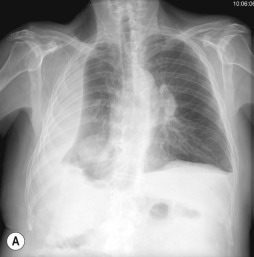
Become a Clinical Tree membership for Full access and enjoy Unlimited articles
If you are a member. Log in here